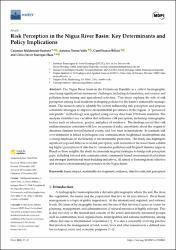Mostrar el registro sencillo del ítem
Risk perception in the Nigua River basin : key determinants and policy implications
| Licencia | This article is an open access article distributed under the terms and conditions of the Creative Commons Attribution (CC BY) license | es |
| Autor | Maldonado-Santana, Casimiro | |
| Autor | Torres-Valle, Antonio | |
| Autor | Franco-Billini, Carol | |
| Autor | Jauregui-Haza, Ulises Javier | |
| Fecha de admisión | 2025-01-16T21:21:06Z | |
| Fecha disponible | 2025-01-16T21:21:06Z | |
| Año | 2024 | |
| Citación | Maldonado-Santana, C., Torres-Valle, A., Franco-Billini, C., & Jauregui-Haza, U. J. (2024). Risk perception in the Nigua River basin: Key determinants and policy implications. Water, 17(1), 45. Recuperado de: | es |
| URI | https://bvearmb.do/handle/123456789/5650 | |
| Sinopsis | The Nigua River basin in the Dominican Republic is a critical hydrographic area facing significant environmental challenges, including deforestation, soil erosion and pollution from mining and agricultural activities. This study explores the role of risk perception among local residents in shaping policies for the basin’s sustainable management. The research aims to identify the factors influencing risk perception and propose actionable strategies to improve environmental governance in the region. A “perceived risk profile” methodology was applied, using survey data from 1223 basin residents. The analysis identified key variables that influence risk perception, including demographic factors such as education, gender, and place of residence. The findings reveal that risk underestimation correlates with low awareness of risks, uncertainty about the origins of disasters, fatalism toward natural events, and low trust in institutions. In contrast, risk over-estimation is linked to infrequent risk communication, heightened catastrophism and a strong emphasis on the benefits of environmental protection. The study also highlights significant regional differences in risk perception, with residents of the lower basin exhibiting higher perceptions of risk due to cumulative pollution and frequent disaster impacts. Based on these insights, the study recommends targeted strategies to bridge risk perception gaps, including tailored risk communication, community-based environmental education and stronger institutional trust-building initiatives, all aimed at fostering more effective and inclusive environmental governance in the Nigua basin. | es |
| Idioma | English | es |
| Publicado | Water, 17(1), 45 | es |
| Derechos | © 2024 by the authors. Licensee MDPI, Basel, Switzerland. | es |
| URI de derechos | https://creativecommons.org/licenses/by/4.0/ | es |
| Materia | Recursos naturales - República Dominicana | es |
| Materia | Recursos hídricos | es |
| Materia | Comunidades rurales | es |
| Materia | Educación ambiental | es |
| Materia | Reducción de riesgos de desastres | es |
| Materia | Gestión ambiental - Políticas y normas | es |
| Título | Risk perception in the Nigua River basin : key determinants and policy implications | es |
| dc.identifier.doi | https://doi.org/10.3390/w17010045 | |
| Tipo de material | Article | es |
| Tipo de contenido | Scientific research | es |
| Acceso | Open | es |
| Audiencia | Technicians, professionals and scientists | es |
Ficheros en el ítem
Este ítem aparece en la(s) siguiente(s) colección(es)
-
Investigación ambiental [1621]


